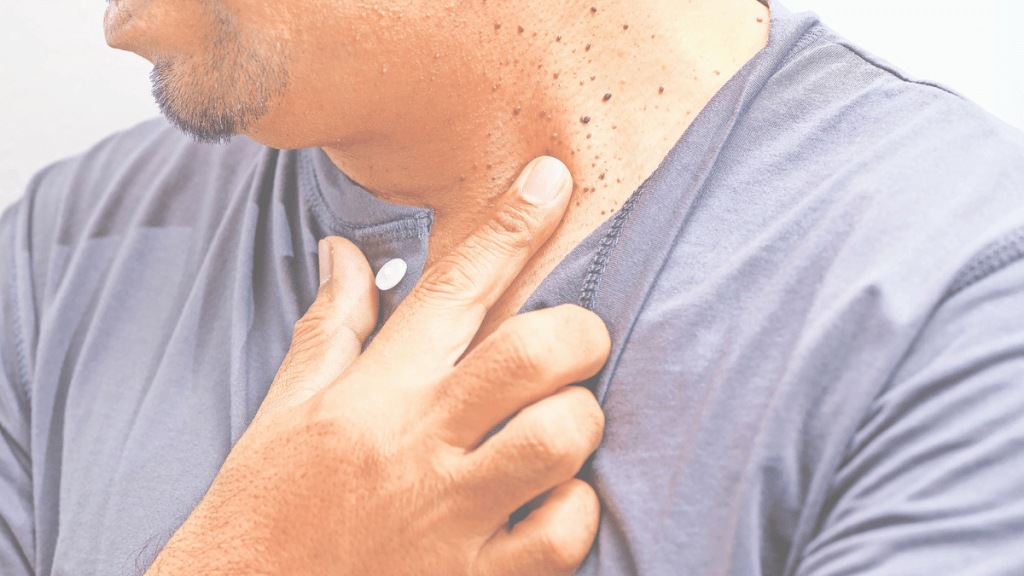Strange growths on skin can be a cause for concern. Dr DM Mahajan, senior consultant, dermatology, Indraprastha Apollo Hospitals, says the most common growths are called skin tags, medically known as acrochordons. They are benign, soft, flesh-coloured or slightly darker outgrowths of skin. They typically appear as small, pendulous sacs of tissue connected to the skin surface by a thin stalk.
Skin tags are composed of loose collagen fibres and blood vessels surrounded by an epithelial layer. The exact cause of skin tags is not fully understood, but several factors contribute to their formation. Friction and irritation play a significant role, as skin tags often develop in areas where skin rubs against skin or clothing, such as the neck, armpits, groin, and under the breasts. Hormonal changes, particularly during pregnancy or in individuals with endocrine disorders, can also promote their growth. Additionally, genetic predisposition, obesity, and certain medical conditions like type 2 diabetes have been associated with an increased likelihood of developing skin tags.
Can they be cancerous?
Skin tags are almost invariably benign (non-cancerous) growths. They are composed of normal skin tissue and do not have the potential to become malignant. The risk of a
skin tag being or becoming cancerous is extremely low, almost negligible. However, it is important to note that while skin tags themselves are not cancerous, other skin growths can sometimes be mistaken for skin tags. In very rare cases, what appears to be a skin tag might actually be a different type of skin lesion, such as a seborrheic keratosis, a mole, or even a small skin cancer. This is why it is crucial to have any new or changing skin growths evaluated by a dermatologist, especially if they exhibit unusual characteristics such as rapid growth, irregular borders, varied colours, or bleeding. If there’s any doubt about the nature of a skin growth, a biopsy can be performed to confirm the diagnosis. Regular skin checks and prompt medical attention for any suspicious growths are key to maintaining skin health and detecting any potential skin cancers early.
How can one prevent skin tags?
Preventing skin tags entirely may not be possible, especially for individuals with a genetic predisposition. However, several measures can be taken to reduce the likelihood of their formation or minimise their occurrence. Maintaining a healthy weight is crucial, as obesity is a risk factor for skin tags. Excess weight can create more skin folds and increase friction, promoting skin tag development. Wearing loose-fitting clothing, particularly in areas prone to friction, can help reduce skin irritation. Keeping skin clean and dry, especially in areas where skin rubs against skin, is important to prevent irritation and bacterial growth. Some dermatologists suggest using powders or antiperspirants in friction-prone areas to reduce moisture and friction. While not scientifically proven, some individuals find that applying vitamin E oil or aloe vera gel to susceptible areas may help keep the skin supple and less prone to irritation.
Do home remedies like tree tea oil work?
The efficacy of home remedies like tea tree oil for treating skin tags is not well-established in clinical literature. While some anecdotal reports suggest that tea tree oil may help dry out and eventually remove skin tags, there is insufficient scientific evidence to support these claims. Tea tree oil does possess antimicrobial and anti-inflammatory properties, which may help reduce irritation around skin tags, but its ability to actually remove them is unproven. Other home remedies such as apple cider vinegar, banana peel, or garlic are similarly lacking in scientific backing. It is important to note that attempting to remove skin tags at home can be risky. Improper removal techniques can lead to bleeding, infection, or scarring.
Additionally, what appears to be a skin tag may sometimes be a different type of skin growth, potentially requiring medical evaluation. For these reasons, dermatologists generally advise against home removal methods. Instead, they recommend professional medical treatments such as cryotherapy, electrocautery, or surgical excision for safe and effective skin tag removal.

